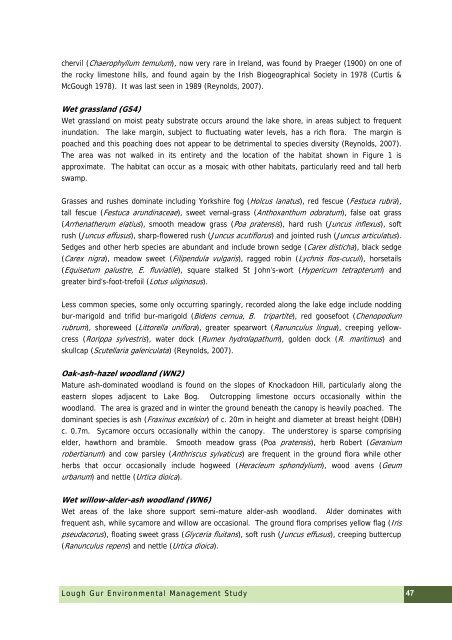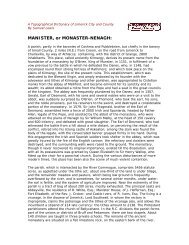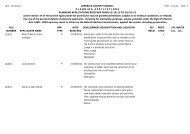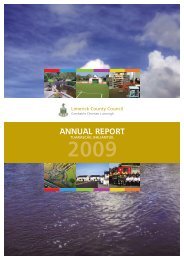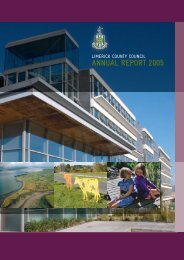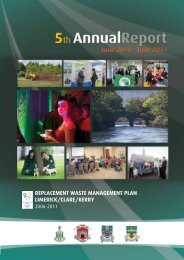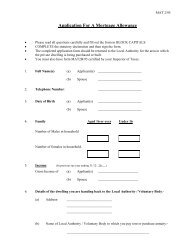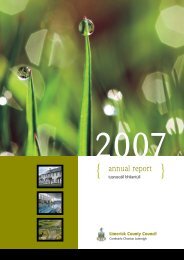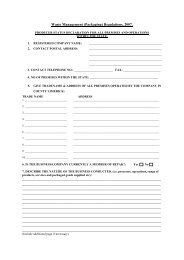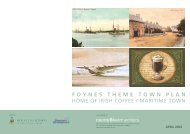Lough Gur Environmental Management Study February 2009
Lough Gur Environmental Management Study February 2009
Lough Gur Environmental Management Study February 2009
You also want an ePaper? Increase the reach of your titles
YUMPU automatically turns print PDFs into web optimized ePapers that Google loves.
chervil (Chaerophyllum temulum), now very rare in Ireland, was found by Praeger (1900) on one of<br />
the rocky limestone hills, and found again by the Irish Biogeographical Society in 1978 (Curtis &<br />
McGough 1978). It was last seen in 1989 (Reynolds, 2007).<br />
Wet grassland (GS4)<br />
Wet grassland on moist peaty substrate occurs around the lake shore, in areas subject to frequent<br />
inundation. The lake margin, subject to fluctuating water levels, has a rich flora. The margin is<br />
poached and this poaching does not appear to be detrimental to species diversity (Reynolds, 2007).<br />
The area was not walked in its entirety and the location of the habitat shown in Figure 1 is<br />
approximate. The habitat can occur as a mosaic with other habitats, particularly reed and tall herb<br />
swamp.<br />
Grasses and rushes dominate including Yorkshire fog (Holcus lanatus), red fescue (Festuca rubra),<br />
tall fescue (Festuca arundinaceae), sweet vernal-grass (Anthoxanthum odoratum), false oat grass<br />
(Arrhenatherum elatius), smooth meadow grass (Poa pratensis), hard rush (Juncus inflexus), soft<br />
rush (Juncus effusus), sharp-flowered rush (Juncus acutiflorus) and jointed rush (Juncus articulatus).<br />
Sedges and other herb species are abundant and include brown sedge (Carex disticha), black sedge<br />
(Carex nigra), meadow sweet (Filipendula vulgaris), ragged robin (Lychnis flos-cuculi), horsetails<br />
(Equisetum palustre, E. fluviatile), square stalked St John’s-wort (Hypericum tetrapterum) and<br />
greater bird’s-foot-trefoil (Lotus uliginosus).<br />
Less common species, some only occurring sparingly, recorded along the lake edge include nodding<br />
bur-marigold and trifid bur-marigold (Bidens cernua, B. tripartite), red goosefoot (Chenopodium<br />
rubrum), shoreweed (Littorella uniflora), greater spearwort (Ranunculus lingua), creeping yellowcress<br />
(Rorippa sylvestris), water dock (Rumex hydrolapathum), golden dock (R. maritimus) and<br />
skullcap (Scutellaria galericulata) (Reynolds, 2007).<br />
Oak-ash-hazel woodland (WN2)<br />
Mature ash-dominated woodland is found on the slopes of Knockadoon Hill, particularly along the<br />
eastern slopes adjacent to Lake Bog. Outcropping limestone occurs occasionally within the<br />
woodland. The area is grazed and in winter the ground beneath the canopy is heavily poached. The<br />
dominant species is ash (Fraxinus excelsior) of c. 20m in height and diameter at breast height (DBH)<br />
c. 0.7m. Sycamore occurs occasionally within the canopy. The understorey is sparse comprising<br />
elder, hawthorn and bramble. Smooth meadow grass (Poa pratensis), herb Robert (Geranium<br />
robertianum) and cow parsley (Anthriscus sylvaticus) are frequent in the ground flora while other<br />
herbs that occur occasionally include hogweed (Heracleum sphondylium), wood avens (Geum<br />
urbanum) and nettle (Urtica dioica).<br />
Wet willow-alder-ash woodland (WN6)<br />
Wet areas of the lake shore support semi-mature alder-ash woodland. Alder dominates with<br />
frequent ash, while sycamore and willow are occasional. The ground flora comprises yellow flag (Iris<br />
pseudacorus), floating sweet grass (Glyceria fluitans), soft rush (Juncus effusus), creeping buttercup<br />
(Ranunculus repens) and nettle (Urtica dioica).<br />
<strong>Lough</strong> <strong>Gur</strong> <strong>Environmental</strong> <strong>Management</strong> <strong>Study</strong> 47


